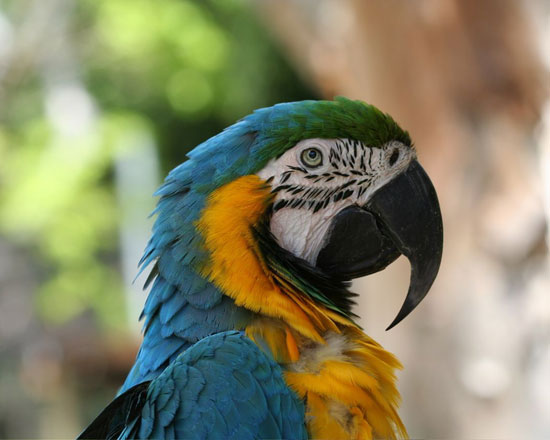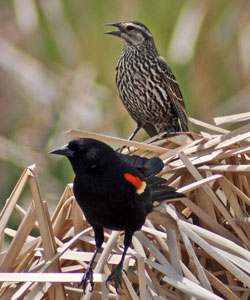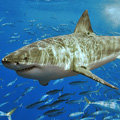« Prev Next »
Behavior: Integrating an Animal’s Internal and External World
How do animals make decisions? Why does a dog, sleeping quietly, get up and search for food, a companion, or ask to be let out of the house? Perceptions of the external world — hearing, vision, smell, and so on — provide information that lead to behavioral changes. Perceptions of the internal world, including hunger, appetite for sex, fear, pain, and the like, provide immediate motivations for behavior. Animals integrate these external and internal inputs to set their behavioral priorities.
Sensing the World
Sensory structures, such as eyes and ears, take information from the environment and convert it into internal signals that the animal can use in shaping its behavior. Transduction is the process of converting external energy, such as light waves, electrical fields, or vibrations in the air into a nervous signal, or action potential. An action potential is an electrical signal that carries information from the sensory organ to the brain via the nervous system. Any imaginable feature of the environment is subject to perception, though not uniformly among all creatures. Evolution tunes any species’ perceptual world to the information available in its habitat. Weakly electric fish, for example, inhabit murky water in which vision is not effective; they navigate and communicate using magnetoreceptors.
Visual perception serves as a good example of a sensory system. Receptive cells for vision contain a pigment — in most animals, the pigment is composed of retinal (derived from vitamin A) and a protein, opsin. Retinal and opsin together form rhodopsin. When light energy (i.e., photons), hits a rhodopsin molecule, the shape of the molecule is altered, triggering a succession of metabolic changes leading to an action potential that transmits the information to the nervous system. When grouped together, pigment containing cells form an eye, an organ that frequently possesses a lens to focus light on the photoreceptive cells.

Some visual pigments respond to a broad range of light frequencies (from ultraviolet to infrared), giving the animal high sensitivity to light and monochromatic (black and white) vision. Other types of visual pigments respond to narrower ranges of light frequency; these typically provide lower light sensitivity, but open the possibility for color vision. Nocturnal animals tend to have monochromatic vision so they can take full advantage of low light levels. Diurnal animals, such as humans and honeybees, can have trichromatic vision (three primary colors that correspond to three different color-responsive pigments). Some animals, such as the Asian Yellow Swallowtail butterfly, can detect as many as five different primary colors (Figure 1).
Animals integrate visual information from just a few to hundreds of thousands of light receptive cells. Some animals form images of their world, while others have visual systems centered more around the detection of movement and/or edges. Remembering and interpreting visual images requires sophisticated central neural processing, and specific brain regions are devoted to this activity in both invertebrates and vertebrates.
The Nervous System and Behavior
The Endocrine System and Behavior

The steroid hormones testosterone and estrogen regulate development of the reproductive system in males and females, as well as the expression of secondary sexual characteristics such as sexual behavior, territoriality, and aggression. The ovaries and testes of vertebrates produce these hormones. Metabolically, estrogen is derived from testosterone, and both hormones are important in shaping female behavior. Simple manipulations, such as removal of the gonads, demonstrate the behavioral importance of estrogen and testosterone. Castrated males — a common practice in the husbandry of dogs, horses and cattle — are less aggressive and more manageable than intact males. Age of castration is important, as once a behavior has developed, removal of the hormone has less effect. Addition of testosterone increases aggression and territoriality. Oxytocin and vasopressin are neurohormones that regulate pair-bonding, a strong connection that develops between males and females of a species, and some aspects of parental care. Neurohormones are produced and released by neurons. These neurohormones are produced in the hypothalamus and secreted from the pituitary. Prolactin, also a product of the hypothalamus, physiologically and behaviorally prepares females for nursing, and stimulates parental care, particularly nesting, in both sexes (Figure 2).
An integrated picture of hormonal regulation of behavior in invertebrates has not yet emerged. Juvenile hormone regulates egg production in nearly all insects and mating behavior in at least some insects. In some social insects, such as the honeybee, juvenile hormone plays an important role in determining which activities a worker performs in the colony. Vitellogenin, a protein stored in eggs for nutrition of the developing embryo, may also affect hormones that determine the age bees perform specific tasks. Ecdysone, or molting hormone, may also have behavioral effects on insects and crustacea, although these have not been as well-investigated. In contrast to insects, bag cell hormones control egg-laying behavior in mollusks.
Appetites
Vertebrates need to sleep. Although the reasons for sleeping are not well understood, there are two hypothesized adaptive functions for sleep. First, it allows a period of brain activity that allows for neural repair and memory consolidation. Second, sleep in a protected location removes an animal from predation risk. Some birds and mammals literally “sleep with one eye open;” one hemisphere of the brain enters a sleep state, while the other remains alert. Sleep is linked to an animal’s circadian clock; active and inactive states are timed internally using a physiological mechanism that cycles approximately each 24 hr. The circadian clock is set by exposure to natural (sun, moon) light cycles, and regulated by hormones like melatonin.

Behavioral thermoregulation is important for both ectotherms and endotherms. Ectotherms may seek sunny locations in which to bask; this warms their body fluids and tissues, allowing for freer muscular movements and faster metabolic processes, such as digestion. Conversely, they seek shade when overheated. Endotherms act in much the same way. Even though they can produce heat internally, and regulate their body temperature physiologically, heat production requires a large amount of energy, and birds and mammals bask to save caloric expenditures (Figure 3).
These examples illustrate how behavioral homeostasis determines much of an animal’s activities. Behavior gives animals the flexibility to respond to changing environmental conditions and to move about in their habitat to find resources that are essential for survival.
Pain
Indecision and Stress
In captivity, the inability to express natural behavior can lead to behavioral pathologies, such as repetitive pacing or grooming, to the point that it causes physical damage. Birds and mammals under behavioral stress may come to exhibit symptoms similar to obsessive-compulsive disorder in humans. They often pull out their feathers or fur, pace, or groom constantly. Animals, particularly carnivores and primates, respond positively to habitats that are relatively complex, or to challenges in food discovery. Modern zoos, conservation/rehabilitation centers, and animal parks, employ both of these techniques to prevent the manifestation of stress behaviors. Medications developed for use in humans to treat anxiety and depression also sometimes help to curb behaviors like paw-licking in dogs and feather plucking in birds.































